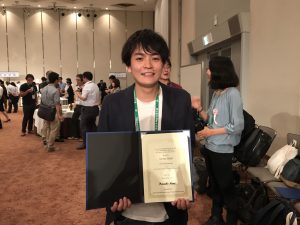本学科4年生の徳田竜也くんが、Neuroscience2017(第40回日本神経科学会大会)にて、Junior Investigator Poster Award(ジュニア研究者ポスター賞)を受賞いたしました。

この学会は、日本神経科学会が主催する国際学会で、世界各国から3000人以上の研究者が参集します。公用語も英語、ポスターも英語での準備となります。このポスター賞は、学部生による優秀なポスター発表に対して授与されるものです。学部時代の研究が対象となるため、ほとんどが修士1年での受賞となりますが、今回の徳田くんは、学部在籍時での受賞という希なケースとなりました。
なお、本研究には、現在、生物統計学研究室所属の4年生、山本周平くんも共同演者として参加しています。
【学会名】Neuroscience 2017 (第40回日本神経科学大会)
【開催期間】2017年7月20日~23日
【開催場所】幕張メッセ
【受賞題目】
Bottom-up algorithm for removing motion artifacts in fNIRS data of children
(小児の光トポグラフィ計測におけるモーションアーチファクト除去アルゴリズムの開発)
【演者】
Tatsuya Tokuda 1:Syuuhei Yamamoto 1:Minako Uga 1,4:Masako Nagashima 2,:Takahiro Ikeda 2:Yukifumi Monden1,2,3:Ippeita Dan 1
1Applied Cognitive Neuroscience Laboratory, Faculty of Science and Technology, Chuo University
2Department of Pediatrics, Jichi Medical University
3Department of Pediatrics, International University of Health and Welfare
4Center for Development of Advanced Medical Technology, Jichi Medical University
【抄録】
Functional near-infrared spectroscopy (fNIRS) non-invasively measures cortical hemodynamic changes hemoglobin species (oxy-Hb and deoxy-Hb) by using two or more near infrared spectra. fNIRS has gained increasing attention lately in neuropsychiatric and cognitive studies of children. In comparison to other authentic neuroimaging modalities such as fMRI, fNIRS has large advantage: it offers less degree of head fixation is less prone to motion artifacts. However, although these merits are generally applicable to adult subjects, it is still difficult to obtain child data without motion artifacts.
The complications of the motion artifacts have been investigated for ages. Nevertheless, it is not easy at all to detect and remove the artifacts by utilizing automatic methods especially for children data. Consequently, such motions artifacts have been detected by raters visually. This further evokes an additional complication: detection and removal of the artifacts is time-consuming and raters’ evaluations may not always match to each other. In order to avoid the complications, we have developed a bottom-up algorithm so as to remove the artifacts based on numerical assessment of child fNIRS data in a similar manner as experienced raters.
We set three criteria for the algorithm. They included positive correlation between oxy-Hb and deoxy-Hb, transition detected per 1 second, and sequential artifacts disrupting correct measurement of the brain activation. By utilizing this algorithm, we reanalyzed the previous research data monitoring the oxy-Hb signal changes of thirty children performing a go/no-go task.
We evaluated activation of right prefrontal cortex during go/no-go task. There was a significant brain activation (t(30)=3.52, p<0.05), which is a comparable degree of activation when artifact removal was performed by experienced raters. Inter-rater agreement between manual detection and the current algorithm was also considerably large (kappa coefficient > 0.7).
We propose that the current algorism can be used for validating previous fNIRS child data in an objective way. However, for its application to novel fNIRS child data, we may need further optimization for parameters used in the algorithm.
